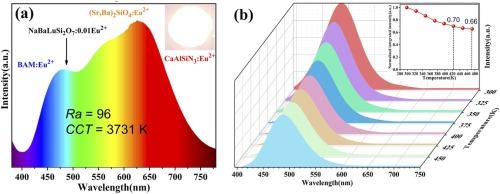纯青色发光荧光粉NaBaLuSi2O7:Eu2+具有高热稳定性,适用于全光谱照明
IF 6.3
2区 材料科学
Q2 CHEMISTRY, PHYSICAL
引用次数: 0
摘要
全光谱照明技术在先进智能光源器件的发展中起着至关重要的作用。然而,实现可靠的青色发射器具有高的颜色纯度和最小的发光热降解仍然是一个重大的挑战。这主要是由于缺乏有效的频谱调制策略和高质量的刚性主机网络结构。在本研究中,在紧密连接的多面体NaBaLuSi2O7主体中加入了发光的Eu2+阳离子中心,在近紫外激发下形成了以479 nm为中心的发射带,完全覆盖了青色光谱区域(450-520 nm)。重要的是,由于其独特的致密三维刚性结构,青色发射器表现出更好的热稳定性,在473 K时保持了66%的发光强度。由于其独特的青色发光特性,将该发射器与三种原色荧光粉结合构建的wled器件获得了极高的显色指数96和低相关色温3731 K,突出了其在全光谱照明方面的巨大潜力。本文章由计算机程序翻译,如有差异,请以英文原文为准。

Pure cyan-emitting phosphor NaBaLuSi2O7:Eu2+ with high thermal stability for full-spectrum lighting
Full-spectrum lighting technology plays a crucial role in the development of advanced intelligent light source devices. However, achieving a reliable cyan emitter with both high color purity and minimal luminescence thermal degradation remains a significant challenge. This is mainly due to the lack of effective spectral modulation strategies and high-quality rigid host network structures. In this study, a luminescent Eu2+ cation center was incorporated into the tightly connected polyhedral NaBaLuSi2O7 host, resulting in an emission band centered at 479 nm under near-ultraviolet excitation, fully covering the cyan spectral region (450-520 nm). Importantly, the cyan emitter displayed improved thermal stability, attributed to its uniquely dense three-dimensional rigid structure, retaining 66% of its luminescence intensity at 473 K. Due to its exceptional cyan luminescence properties, the WLEDs device constructed by combining this emitter with three primary color phosphors achieved an exceptionally high color rendering index 96 and a low correlated color temperature 3731 K, highlighting its significant potential for full-spectrum lighting.
求助全文
通过发布文献求助,成功后即可免费获取论文全文。
去求助
来源期刊

Journal of Alloys and Compounds
工程技术-材料科学:综合
CiteScore
11.10
自引率
14.50%
发文量
5146
审稿时长
67 days
期刊介绍:
The Journal of Alloys and Compounds is intended to serve as an international medium for the publication of work on solid materials comprising compounds as well as alloys. Its great strength lies in the diversity of discipline which it encompasses, drawing together results from materials science, solid-state chemistry and physics.
 求助内容:
求助内容: 应助结果提醒方式:
应助结果提醒方式:


